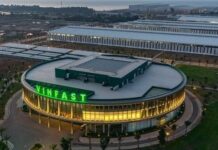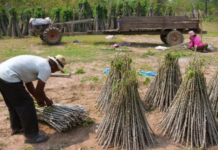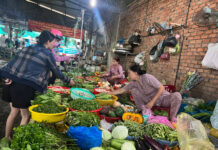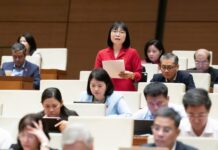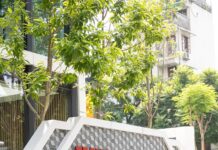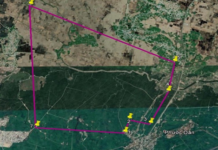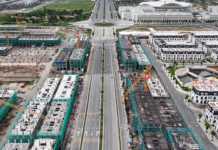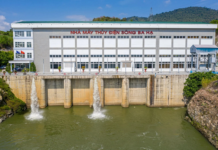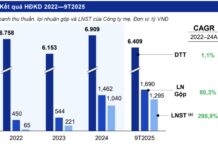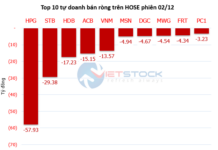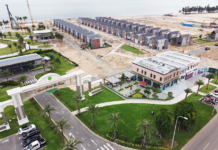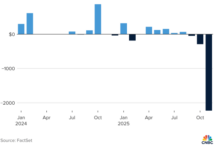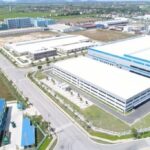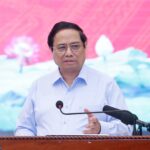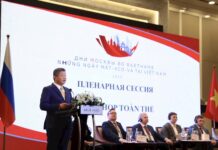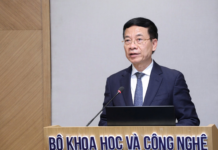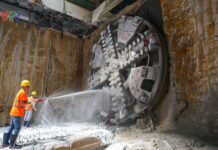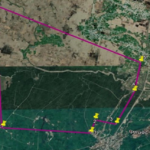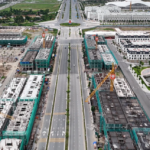
The establishment of the Free Trade Area is expected to create a great impetus to promote the socio-economic development of Danang – Photo: VGP/Minh Trang
An Economic Driver for the Region
At the 7th Session of the 15th National Assembly, a resolution was passed on the organization of urban administration and the pilot of several mechanisms and special policies for the development of Danang City. For the first time in the country, the National Assembly allowed Danang to pilot the establishment of a Free Trade Area. This move is expected to create a significant boost for the socio-economic development of Danang City and the surrounding region.
Immediately after the 15th National Assembly Session, in a report to the voters of Danang City, Mr. Nguyen Van Quang, Secretary of the Danang Party Committee, affirmed that the National Assembly’s decision to allow Danang to pilot the establishment of a Free Trade Area is a major policy with great significance. He described it as a “boost” and a driving force for the economy of Danang City in particular and the region in general.
Mr. Quang, Secretary of the Danang Party Committee, considers the Free Trade Area pilot policy as a breakthrough, reflecting a bold and innovative approach to testing a model that has been proven successful globally but has no precedent in Vietnam.
According to Mr. Tran Chi Cuong, Vice Chairman of the Danang People’s Committee, the permission to pilot the establishment of the Danang Free Trade Area will provide an effective legal basis for the locality to promote its potential and advantages.
Mr. Cuong stated, “The resolution on the organization of urban administration and the pilot of several mechanisms and special policies for the development of Danang City, which was recently passed by the National Assembly, has a unique and superior character. It aims to overcome limitations and bottlenecks in the implementation of Resolution No. 119/2020/QH14. This will facilitate the unlocking of resources and create a new impetus for the development of Danang City, providing an effective legal basis to harness its potential and advantages, address bottlenecks, and promote the socio-economic development of the city.”
The formation of the Danang Free Trade Area is expected to contribute significantly to attracting FDI to Danang and the dynamic region of Central Vietnam, promoting the socio-economic development of the region and the country. It will also diversify commercial and tourism activities, in line with the city’s central role.”

The High-Tech Park is expected to become a production hub within the Free Trade Area – Photo: VGP/Minh Trang
Unleashing Resources and Potential
According to Ms. Le Thi Kim Phuong, Director of the Department of Industry and Trade of Danang City, allowing Danang to pilot the establishment of a Free Trade Area will help the city unleash its resources, thereby having a very strong and positive impact on its development in the coming time.
The Danang Free Trade Area will boost the growth of goods through the city’s seaports, propel Danang to become the central region’s hub for maritime logistics, and bring about numerous positive impacts on the economy.
Specifically, the Danang Free Trade Area will promote logistics activities and enhance the value of the tourism and commercial sectors in Vietnam, particularly in Danang City. It will create a chain of high-end products and services (tourism, retail, entertainment, etc.), contributing to attracting tourists to Danang and the Central Highlands region.
Additionally, the establishment of the Danang Free Trade Area can bring indirect benefits, such as attracting headquarters of large corporations, fostering scientific and technological innovations, developing maritime economics, and attracting talented individuals. These factors will have a significant impact on the socio-economic landscape.

The Danang Free Trade Area is an attractive factor for large “eagles” to invest – Photo: VGP/Minh Trang
Concurring with the above assessments, Mr. Vu Quang Hung, Head of the Management Board of the High-Tech Park and Industrial Zones of Danang, believes that the Free Trade Area model will enable Danang to become the economic locomotive.
Mr. Hung stated, “With its strategic location, Danang has a deep-water seaport, an international airport, a coastal border area, and a land border area. It is also the endpoint of the East-West Economic Corridor. Danang is well-positioned to establish a Free Trade Area where foreign businesses and investors can bring goods, organize production, process, package, and label products for export to other countries or for domestic consumption. This is a significant advantage for Danang.”
Based on this, the Head of the Management Board of the High-Tech Park and Industrial Zones of Danang emphasized that once the Danang Free Trade Area is established, it will be linked to the Lien Chieu Port and Danang International Airport. This will promote production, processing, recycling, assembly, classification, packaging of export and import goods, and the provision of logistics services, establishing an international cargo transshipment center. It will also contribute to a more comprehensive infrastructure structure and maximize the value chain of seaports and airports.
Additionally, the Free Trade Area will effectively connect production infrastructure and complementarily support new industrial and cluster zones that will develop in the future. It will also connect with inland ports, railway stations, and major transportation axes.

The area behind Lien Chieu Seaport is expected to be developed into a logistics hub – Photo: VGP/Minh Trang
Nine Proposed Construction Sites
According to the Danang Department of Construction, the city will construct a dispersed Free Trade Area with nine proposed sites to be developed into functional zones: production, logistics, and commercial-service zones, spanning over 1,700 hectares.
These nine sites have been proposed by departments, branches, and districts, including: Site 1, located behind Lien Chieu Seaport (east of Lien Chieu Seaport and west of Lien Chieu Industrial Park) in Hoa Hiep Bac Ward (Lien Chieu District), with an area of about 100 hectares, designated for logistics functions.
Site 2 is a 100-hectare area along the Nam Hai Van Bypass Road (east of Lien Chieu Industrial Park) from Cu De River to north of the Nam Hai Van Transit Station in Hoa Hiep Bac Ward, intended for logistics activities.
Site 3 is a 400-hectare area north of Cu De River in Hoa Lien Commune (Hòa Vang District), planned for production activities.
Site 4 has a total area of 559 hectares, comprising the Danang High-Tech Park with an area of 259 hectares and an additional 300 hectares for the park’s expansion in Hoa Ninh Commune (Hòa Vang District). It is designated for production activities.
Site 5 is located at the foot of Ba Na Mountain in Hoa Ninh Commune, spanning about 90 hectares, and is intended for commercial and service functions.
Site 6 is on both sides of the Ba Na – Suoi Mo Road, adjacent to the East Lake to the northeast, with an area of about 154 hectares in Hoa Nhon Commune (Hòa Vang District). It is planned for commercial and service functions.
Site 7 is also on both sides of the Ba Na – Suoi Mo Road, adjacent to the East Lake to the southwest, with an area of about 53 hectares in Hoa Nhon Commune, designated for commercial and service functions.
Site 8 is located in the planned area of Hoa Nhon Industrial Park, covering about 200 hectares, intended for logistics activities.
Site 9 is in the southwest of Danang Airport (adjacent to Truong Chinh Street) with an area of about 80 hectares, planned for logistics functions.
Thus, according to their functional areas, the proposed sites can be categorized into groups: commercial and service zones (including Sites 5, 6, and 7) with a total area of about 297 hectares; production zones (including Sites 3 and 4) with a total area of about 700 hectares, excluding the existing 259-hectare Danang High-Tech Park; and logistics zones (including Sites 1, 2, 8, and 9) with a total area of about 480 hectares.
In addition to these nine sites, during the process of studying and formulating the proposal for the establishment of the Danang Free Trade Area, the city will continue to consider, supplement, and adjust the sites to ensure feasibility in implementation.
There is also a tenth proposed site, involving land reclamation along the coastline of Nguyen Tat Thanh Street, extending into Danang Bay – from Nguyen Sinh Sac Street to the boundary of the Da Phuoc International Urban Area, with a total area of 420 hectares, intended for the Free Trade Area.
“Save 30% on Delivery Fees with Ahamove’s ‘Cost-Effective Truck’ Service”
Oversized cargo is no longer a worry with our cost-effective truck delivery service, offering savings of up to 30% and a swift 4-hour delivery window. It’s time for small and medium-sized businesses to take control of their logistics operations with this modern and efficient solution.
“A Vision for Prosperity: Elevating Dong Nai’s Economy to the Forefront of Vietnam”
Working alongside the leadership of Dong Nai province, Prime Minister Pham Minh Chinh proposed that the province should embrace the spirit of “3 pioneers” and focus on 8 key tasks. The aim is to propel Dong Nai to the forefront of economic development in Vietnam, envisioning it as a province renowned for its civility, modernity, and high income, placing it among the nation’s elite.

